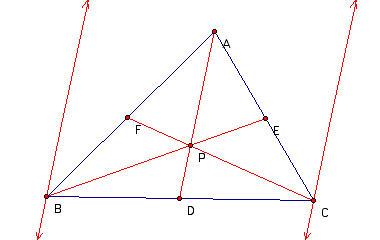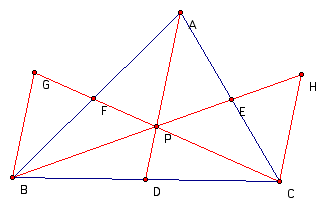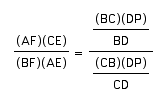

Consider any triangle ABC. Select a point P inside the triangle and draw lines AP, BP, and CP extended to their intersections with the opposite sides in points D, E, and F respectively.

Explore (AF)(BD)(EC) and (FB)(DC)(EA) for various triangles and various locations of P. Prove any conjecture.
I plan to prove the following:

We begin by looking at our drawing above. First, we will add two lines parallel to AD. One will intersect point B and the other will intersect point C, as follows:

Next, we will extend CF and BE so that they intersect the new lines at points G and H respectively.

We will now describe several sets of similar triangles.
Since BG is parallel to AD, we can see that angle BGF is congruent to angle APF. Similarly, we see that angle GBF is congruent to angle PAF. And finally, we see that angle BFG is congruent to angle AFP since they are vertical angles. Therefore, we know that triangle BFG is similar to triangle AFP by the AAA Theorem. This leads to the following ratios:

Since CH is parallel to AD, we can see that angle CHE is congruent to angle APE. Similarly, we see that angle HCE is congruent to angle PAE. And finally, we see that angle CEH is congruent to angle AEP since they are vertical angles. Therefore, we know that triangle CEH is similar to triangle AEP by the AAA Theorem. This leads to the following ratios:

Since BG is parallel to AD, we can see that angle GBC is congruent to angle PDC. Similarly, we see that angle BGC is congruent to angle DPC. And finally, we see that angle BCG is congruent to angle DCP since they are the same angle. Therefore, we know that triangle BGC is similar to triangle DPC by the AAA Theorem. This leads to the following ratios:

Since CH is parallel to AD, we can see that angle HCB is congruent to angle PDB. Similarly, we see that angle CHB is congruent to angle DPB. And finally, we see that angle CBH is congruent to angle DBP since they are the same angle. Therefore, we know that triangle CHB is similar to triangle DPB by the AAA Theorem. This leads to the following ratios:

From equation (3), we get the following:

Which can be rearranged as follows:

From equation (4), we get the following:

Which can be rearranged as follows:

From equation (1), we get the following:

From equation (2), we get the following:

Multiplying these last two equations together gives us the following:

which simplifies to:

If we substitute equations (5) and (6) into equation (7) we get the following:

which simplifies to:

which results in the following:

And the proof is complete.
What if point P is outside of the triangle? Will the proof still hold?
Click here for a GSP sketch to explore.
What is the ratio of the areas of triangle ABC and triangle DEF? Can it ever be less than 4?
Click here for a GSP sketch to explore.